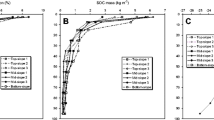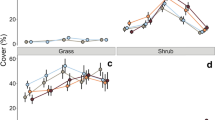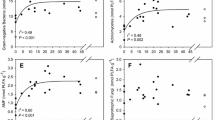Abstract
While recent research has focused on the effects of exotic plant species on ecosystem properties, less is known about how restoring individual native plant species, differing in biomass and tissue chemistry, may impact ecosystems. We examined how three native C4 prairie grasses affected soil C and N cycling 11 years after reintroduction into successional old-field communities dominated by non-native C3 grasses. The species examined in this study differ in traits that are expected to influence soil C and N cycling (biomass and tissue chemistry). Thus, we hypothesized that cycling rates would decrease, thereby increasing pool sizes in soils under C4 species compared under C3 species. As predicted, the C4 species had greater biomass and more recalcitrant tissue [higher C:N, acid detergent fiber (ADF):N] compared to the dominant C3 species. The three C4 species did not differ in tissue C:N, ADF:N, or root biomass, but Andropogon had more than twice the shoot biomass of Schizachyrium and Sorghastrum. Soils under the C4 species did not differ in inorganic N levels, but levels were lower than in soils under the C3 species, and soils under Andropogon had slightly lower in situ net N mineralization rates compared to those under C3 species. We found little evidence of larger surface soil C pools under C4 species versus C3 species after 11 years and no differences in subsurface soil C or N among species. The C4 species contributed a significant amount of C to both soil depths after 11 years. Our results demonstrate that C4 species reintroduction into old-fields can alter C and N cycling on relatively short timescales, and that individual C4 species differ in the magnitude of these effects. Improving our understanding of how species influence ecosystem properties is essential to predicting the ecosystem-level consequences of plant community alterations due to land use changes, global change, and species introductions.




Similar content being viewed by others
References
Averett JM, Klips RA, Nave LE, Frey SD, Curtis PS (2004) Effects of soil carbon amendment on nitrogen availability and plant growth in an experimental tallgrass prairie restoration. Restor Ecol 12:568–574
Baer SG, Kitchen DJ, Blair JM, Rice CW (2002) Changes in ecosystem structure and function along a chronosequence of restored grasslands. Ecol Appl 12:1688–1701
Burbank DH, Pregitzer KS, Gross KL (1992) Vegetation of the W.K. Kellogg Biological Station, Kalamazoo County, Michigan. Michigan State University Agricultural Experiment Station, East Lansing, p 72
Camill P et al (2004) Community- and ecosystem-level changes in a species-rich tallgrass prairie restoration. Ecol Appl 14:1680–1694
Carney KM, Matson PA (2005) Plant communities, soil microorganisms, and soil carbon cycling: does altering the world belowground matter to ecosystem functioning? Ecosystems 8:928–940
Chapin FS et al (2000) Consequences of changing biodiversity. Nature 405:234–242
Collatz GJ, Berry JA, Clark JS (1998) Effects of climate and atmospheric CO2 partial pressure on the global distribution of C-4 grasses: present, past, and future. Oecologia 114:441–454
Craine JM, Tilman D, Wedin D, Reich P, Tjoelker M, Knops J (2002a) Functional traits, productivity and effects on nitrogen cycling of 33 grassland species. Funct Ecol 16:563–574
Craine JM, Wedin DA, Chapin FS, Reich PB (2002b) Relationship between the structure of root systems and resource use for 11 North American grassland plants. Plant Ecol 165:85–100
Craine JM, Lee WG, Bond WJ, Williams RJ, Johnson LC (2005) Environmental constraints on a global relationship among leaf and root traits of grasses. Ecology 86:12–19
DeGryze S, Six J, Paustian K, Morris SJ, Paul EA, Merckx R (2004) Soil organic carbon pool changes following land-use conversions. Glob Chang Biol 10:1120–1132
Dijkstra FA, Hobbie SE, Reich PB (2006) Soil processes affected by sixteen grassland species grown under different environmental conditions. Soil Sci Soc Am J 70:770–777
Epstein HE, Lauenroth WK, Burke IC, Coffin DP (1997) Productivity patterns of C-3 and C-4 functional types in the US Great Plains. Ecology 78:722–731
Epstein HE, Gill RA, Paruelo JM, Lauenroth WK, Jia GJ, Burke IC (2002) The relative abundance of three plant functional types in temperate grasslands and shrublands of North and South America: effects of projected climate change. J Biogeogr 29:875–888
Evans RD, Rimer R, Sperry L, Belnap J (2001) Exotic plant invasion alters nitrogen dynamics in an arid grassland. Ecol Appl 11:1301–1310
Eviner VT, Chapin FS, Vaughn CE (2006) Seasonal variations in plant species effects on soil N and P dynamics. Ecology 87:974–986
Foster BL (1999) Establishment, competition and the distribution of native grasses among Michigan old-fields. J Ecol 87:476–489
Foster BL, Gross KL (1997) Partitioning the effects of plant biomass and litter on Andropogon gerardi in old-field vegetation. Ecology 78:2091–2104
Garten CT (1993) Variation in foliar N-15 abundance and the availability of soil-nitrogen on walker branch watershed. Ecology 74:2098–2113
Garten CT, Vanmiegroet H (1994) Relationships between soil-nitrogen dynamics and natural N-15 abundance in plant foliage from Great Smoky Mountains National Park. Can J For Res 24:1636–1645
Gotshall TB (1972) The vegetation of Kalamazoo County at the time of settlement. In: Brewer R (ed) The ecology of Kalamazoo County. Western Michigan University Press, Kalamazoo, pp 1–21
Grandy AS, Loecke TD, Parr S, Robertson GP (2006) Long-term trends in nitrous oxide emissions, soil nitrogen, and crop yields of till and no-till cropping systems. J Environ Qual 35:1487–1495
Gross KL, Emery SM (2007) Succession and restoration in Michigan old-field communities. In: Cramer VA, Hobbs RJ (eds) Old fields: dynamics and restoration of abandoned farmland. Island Press, Washington, DC, pp 221–243
Hobbie SE (1992) Effects of plant species on nutrient cycling. TREE 7:336–339
Hooper DU, Vitousek PM (1998) Effects of plant composition and diversity on nutrient cycling. Ecol Monogr 68:121–149
Hooper DU et al (2005) Effects of biodiversity on ecosystem functioning: a consensus of current knowledge. Ecol Monogr 75:3–35
Inouye RS, Tilman D (1988) Convergence and divergence of old-field plant-communities along experimental nitrogen gradients. Ecology 69:995–1004
Inouye RS, Tilman D (1995) Convergence and divergence of old-field vegetation after 11 yr of nitrogen addition. Ecology 76:1872–1887
Knops JMH, Tilman D (2000) Dynamics of soil nitrogen and carbon accumulation for 61 years after agricultural abandonment. Ecology 81:88–98
Kucharik CJ (2007) Impact of prairie age and soil order on carbon and nitrogen sequestration. Soil Sci Soc Am J 71:430–441
Lal R, Follett RF, Kimble J, Cole CV (1999) Managing US cropland to sequester carbon in soil. J Soil Water Conserv 54:374–381
Lawton JH, May RM (eds) (1995) Extinction rates. Oxford University Press, New York
Mack MC, D’Antonio C (2003) Exotic grasses alter controls over soil nitrogen dynamics in a Hawaiian woodland. Ecol Appl 13:154–166
McLauchlan KK, Hobbie SE, Post WM (2006) Conversion from agriculture to grassland builds soil organic matter on decadal timescales. Ecol Appl 16:143–153
Mlot C (1990) Restoring the prairie. Bioscience 40:804–809
Pimm SL, Russell GJ, Gittleman JL, Brooks TM (1995) The future of biodiversity. Science 269:347–350
Reich PB et al (2004) Species and functional group diversity independently influence biomass accumulation and its response to CO2 and N. Proc Natl Acad Sci USA 101:10101–10106
Robertson GP, Coleman DC, Bledsoe CS, Sollins P (eds) (1999) Standard soil methods for long-term ecological research. Oxford University Press, New York
Samson F, Knopf F (1994) Prairie conservation in North-America. Bioscience 44:418–421
Samson R et al (2005) The potential of C-4 perennial grasses for developing global BIOHEAT industry. Crit Rev Plant Sci 24:461–495
Sanderson MA, Adler PR, Boateng AA, Casler MD, Sarath G (2006) Switchgrass as a biofuels feedstock in the USA. Can J Plant Sci 86:1315–1325
Templer PH, Arthur MA, Lovett GM, Weathers KC (2007) Plant and soil natural abundance delta N-15: indicators of relative rates of nitrogen cycling in temperate forest ecosystems. Oecologia 153:399-406
Tilman D, Hill J, Lehman C (2006) Carbon-negative biofuels from low-input high-diversity grassland biomass. Science 314:1598–1600
Tjoelker MG, Craine JM, Wedin D, Reich PB, Tilman D (2005) Linking leaf and root trait syndromes among 39 grassland and savannah species. New Phytol 167:493–508
Vinton MA, Goergen EM (2006) Plant-soil feedbacks contribute to the persistence of Bromus inermis in tallgrass prairie. Ecosystems 9:967–976
Vitousek PM, Walker LR (1989) Biological invasion by Myrica faya in Hawaii—plant demography, nitrogen-fixation, ecosystem effects. Ecol Monogr 59:247–265
Wardle DA, Bonner KI, Nicholson KS (1997) Biodiversity and plant litter: experimental evidence which does not support the view that enhanced species richness improves ecosystem function. Oikos 79:247–258
Wardle DA, Barker GM, Bonner KI, Nicholson KS (1998) Can comparative approaches based on plant ecophysiological traits predict the nature of biotic interactions and individual plant species effects in ecosystems? J Ecol 86:405–420
Wardle DA, Bardgett RD, Klironomos JN, Setala H, van der Putten WH, Wall DH (2004) Ecological linkages between aboveground and belowground biota. Science 304:1629–1633
Wedin DA, Tilman D (1990) Species effects on nitrogen cycling: a test with perennial grasses. Oecologia 84:433–441
Wedin DA, Tieszen LL, Dewey B, Pastor J (1995) Carbon-isotope dynamics during grass decomposition and soil organic-matter formation. Ecology 76:1383–1392
Winslow JC, Hunt ER, Piper SC (2003) The influence of seasonal water availability on global C-3 versus C-4 grassland biomass and its implications for climate change research. Ecol Model 163:153–173
Zak DR, Holmes WE, White DC, Peacock AD, Tilman D (2003) Plant diversity, soil microbial communities, and ecosystem function: are there any links? Ecology 84:2042–2050
Zavaleta ES, Hulvey KB (2007) Realistic variation in species composition affects grassland production, resource use and invasion resistance. Plant Ecol 188:39–51
Acknowledgements
We thank Carol Baker and members of the Gross lab for field and laboratory assistance. We thank Merritt Turetsky, Neville Millar, and Claire Treat for analytical assistance. Christopher Blackwood provided invaluable statistical advice and assistance. This study and the resulting manuscript benefited from comments from Peter Murphy, Stephen Hamilton, Merritt Turetsky, Terry Loecke, Bryan Foster, and G. Philip Robertson. Financial assistance was provided by the NSF Long-Term Ecological Research Program DEB 0423627 and George H. Lauff Research Awards. This is KBS contribution number 1466.
Author information
Authors and Affiliations
Corresponding author
Additional information
Communicated by Alan Knapp.
Rights and permissions
About this article
Cite this article
Mahaney, W.M., Smemo, K.A. & Gross, K.L. Impacts of C4 grass introductions on soil carbon and nitrogen cycling in C3-dominated successional systems. Oecologia 157, 295–305 (2008). https://doi.org/10.1007/s00442-008-1063-5
Received:
Accepted:
Published:
Issue Date:
DOI: https://doi.org/10.1007/s00442-008-1063-5




